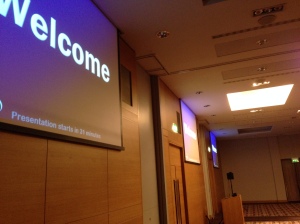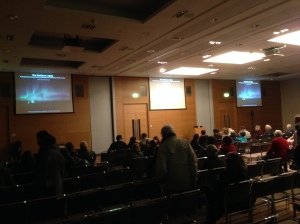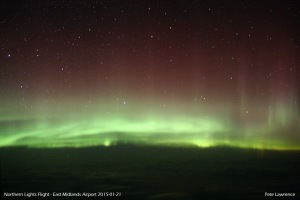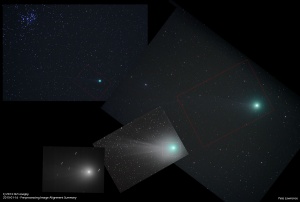Every year from November to March I’m employed as an expert guide on a number of aurora expeditions. Most of these don’t land but rather take people to the edge of British airspace in a totally darkened plane to look out in hope of spotting the elusive aurora. The big advantage here is that at a height of 36,000 feet, it’s extremely unusual to get any weather in the way which would otherwise spoil the view.
I’ve been doing this for 10 years, together with a team which works extremely well together. The format of each flight is exactly the same. Passengers gather in a predefined location beforehand in anticipation of a live presentation given by two astronomers, one of which tends to be me. The period before the presentation start time is covered by a multi-media pre-presentation, presentation (PPP) which addresses many of the questions we used to get after each flight. It also introduces the passengers to the team.
I used to write computer software for a living and wrote the scripting language for the PPP. This gives me a lot of flexibility when putting the PPP together. It also allows for problems that sometimes occur when we can’t start the PPP rolling on time. The current version can auto-scale itself to start at any time before the main presentation. Music and graphics always stop at the correct time just before the main, live-presentation. The biggest benefit though, is that I have total control over the PPP’s content and can customised for each flight beforehand. All I need to do is turn up, activate the program and relax – well sort of! The PPP counts down to the start of the main presentations and it’s atomic clock accurate!
What follows is a brief introduction from an Omega Holidays representative – typically Peter Truman, who initially came up with the idea – and then into the main presentations. Both run for 30 minutes each. The first covers some of the procedures of the flight and a guide to the main patterns of stars that passengers will see outside. The second, describes the aurora; where it comes from, what it looks like and a forecast for our chances of seeing it on the flight.
After this, the next stage is getting on-board the plane. After take off, a short food service normally occurs and then, approximately 40 minutes in, the astronomers attempt to get the cabin as dark as possible. Once this has been done, passengers normally have 20-30 minutes in darkness before we arrive on ‘station’. This is the term used to describe our location, typically between 58 and 61 degrees north, and to the west of the Shetland Islands (out of light pollution range from the islands). Here, the plane takes up an east-west and west-east circuit allowing each side of the aircraft a look towards the north where hopefully the aurora will be putting on a show.
Out of the 250+ flights I’ve now done we’ve not seen any hint of the aurora on just 8 of them. However, in fairness, some of the sightings have been extremely weak displays but the Northern Lights all the same.
The January 2015 season started with a flight from Glasgow Airport. I live on the UK’s south coast and Glasgow is a long drive for me. When we got on board, an operational issue with flight path planning meant we took off 90 minutes late. As it happened this worked to our favour because we got a lovely display of the Northern Lights which we may not have seen had we taken off on time!
The next night was from Edinburgh which had a weak display. Unusually for us, the following displays from Newcastle, Stansted and Bristol were also rather weak, the Bristol display being virtually non existent! However, the aurora sorted itself out for the last two flights in January from East Midlands Airport and Leeds-Bradford. Both were nail-biters in that the aurora remained misty and indistinct until right up to the last minute when suddenly it burst into life. Fortunately, the Jet2 crews we had on these flights were very understanding and made extra circuits so everyone could get a look. Lots of happy faces leaving the aircraft after those two.
The flights are pretty exhausting to do for the team. In this instance they were arranged as three on (Glasgow, Edinburgh and Newcastle), a one day gap before Stansted and another rest day before the final three (Bristol, East Midlands and Leeds-Bradford). My typically complicated diary meant that the rest day between Stansted and Bristol needed to be be used for my Sky at Night filming duties. I drove straight from Stansted to the Winchester Science Centre, filmed during the afternoon and returned home at 20:30.
It was clear when I got back so after a bit of internal negotiation between my brain and body, I managed to set up my kit to take some shots of the beautiful comet C/2014 Q2 Lovejoy. Of course, finding the time to process these results is the next hurdle to overcome!
You can see scheduling information and previous flight photos from my Aurora Flights website.





